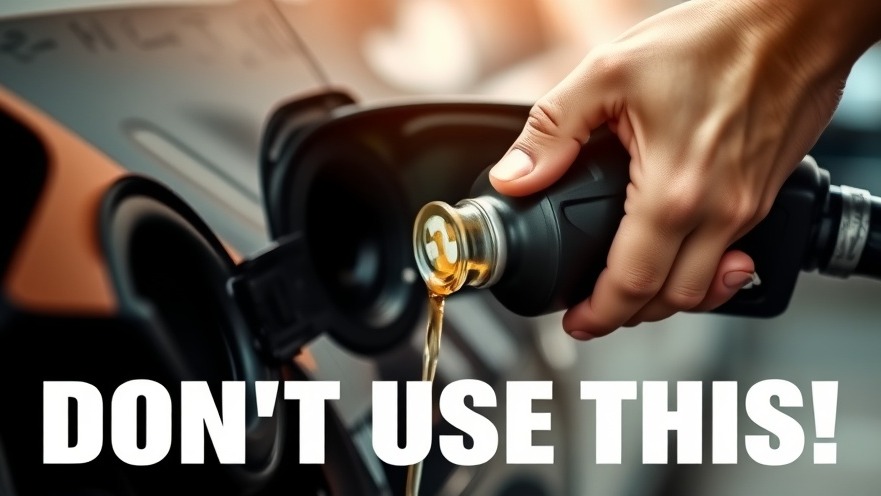
Understanding Fuel Additives: What Every Car Owner Should Know
Every year, drivers waste over $500 million on ineffective fuel additives. That's a staggering amount of money, especially considering that many of these products do little more than occupy shelf space at auto parts stores. However, understanding the right fuel additives can transform your vehicle’s performance and fuel economy significantly.
In '13 Fuel Additives Mechanics Don’t Want You to Know', the discussion dives into the realm of effective fuel additives, shedding light on which products stand out and which ones fail, offering insights that we’re exploring further in this article.
The Power of Fuel Injector Cleaners
When it comes to maintaining optimal engine function, fuel injector cleaners stand out. Products like Chevron Techron Concentrate Plus have become household names because of their proven effectiveness. This cleaner's secret ingredient, polyetheramine, actively breaks down carbon deposits and varnish within the fuel system, delivering remarkable results. For drivers who experience engine misfires or rough idles, adding a bottle of this into your tank can lead to smoother operations.
In the realm of European vehicles, the Liqui Moly Jectron has made a name for itself. Known for its compatibility with cars from manufacturers like Audi or BMW, it expertly tackles carbon buildup, enhancing throttle response and improving overall engine power. This specialized cleaner makes a compelling case for anyone with a high-mileage European vehicle.
Exploring High-Performance Additives
Moving beyond cleaners, high-performance additives like Royal Purple Max Clean and Boostane Professional Octane Booster spark considerable interest among car enthusiasts. Royal Purple promises up to 3.2% gains in fuel economy and reduces harmful emissions by up to 18%. Whether your vehicle is gas or diesel, this additive caters to a wide array of engines, ensuring improved performance. On the other hand, Boostane takes your regular fuel and enhances its octane level significantly, resembling race fuel. This is particularly advantageous for modified engines that demand higher performance during high-stress conditions.
The Risks of Non-Essential Additives
However, caution is warranted. Many products on the market are mere scams, offering little to no benefit. For instance, Gum Out Regane and Lucas Upper Cylinder Lubricant have been criticized for their inefficacy, leaving car owners wasting their hard-earned cash. Drivers should be wary of additives that lack scientific backing and avoid those that might even harm their engine.
The Importance of Diesel Additives
A well-maintained diesel engine is significant, and using the right diesel additives can drastically prevent costly repairs. The Hot Shot Secret Everyday Diesel Treatment is invaluable for its ability to enhance lubricity and protect high-pressure fuel systems. It's especially crucial for those who rely on diesel vehicles for heavy-duty tasks.
Moreover, the Power Service Diesel Clean Plus Cetane Boost offers benefits by improving cold starts and reducing smoke, essential for maintaining engine longevity. Such products are must-haves for those who drive diesel-powered vehicles, as they can save significant costs associated with repairs.
The Hidden Risks of Water in Fuel Systems
Water contamination remains a hidden enemy for car owners, where products like STP Water Remover and Fuel Line Antifreeze come into play. This inexpensive solution effectively removes moisture before it can wreak havoc on your vehicle’s fuel system. Having this antifreeze product during winter months can help eliminate problems associated with frozen fuel lines, ensuring smooth starts.
Conclusion: Make Smart Fuel Additive Choices
Understanding which fuel additives deliver real results versus those that just promise the world is crucial for car owners. By investing in reliable products, one can also enhance engine performance, improve fuel economy, and avoid unnecessary repairs. For those who care about the health of their vehicle, educating yourself on what works and what doesn’t is key. Exploring reputable brands and trusted solutions will prolong your engine’s lifespan and keep your maintenance costs lower.
Now that you’re armed with knowledge about effective and ineffective fuel additives, consider checking your own garage for products you might want to avoid. Ensure that every bottle you choose contributes positively to your vehicle’s performance and longevity!
 Add Row
Add Row  Add
Add 




Write A Comment